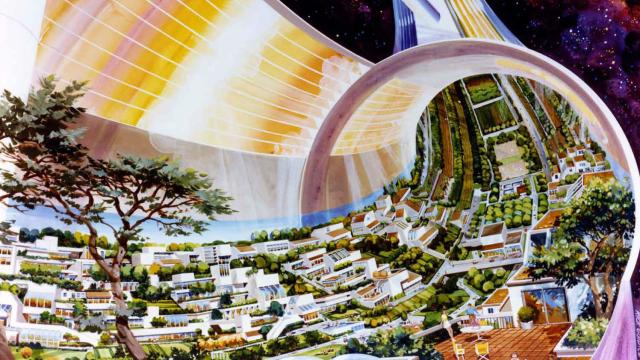Forget the flying cars and robot maids, we’re just a few precious generations away from ditching this hunk of space rock called Earth and living among the stars. The dream of off-world living is thanks, in large part, to a single Princeton physics professor who not only envisioned a new path for humanity but nearly convinced Congress to go along with it. Piers Biznoy explains just how close we came to building orbital habitats in the 1980s in his new book New Space Frontiers.
Cities in Space
Today it is hard to imagine a time when US Senators listened in rapt attention while a charismatic lecturer argued for the construction of giant orbiting habitats as a way of easing environmental pressures on Earth. The structures, at least two miles long, would support thousands of people, all living in leafy suburbs. In January, 1976 it was possible for Gerard K. O’Neill, a physics professor at Princeton University, to talk about space colonies without sounding like a dreamer. Whatever happened to an idea that once captivated the world?
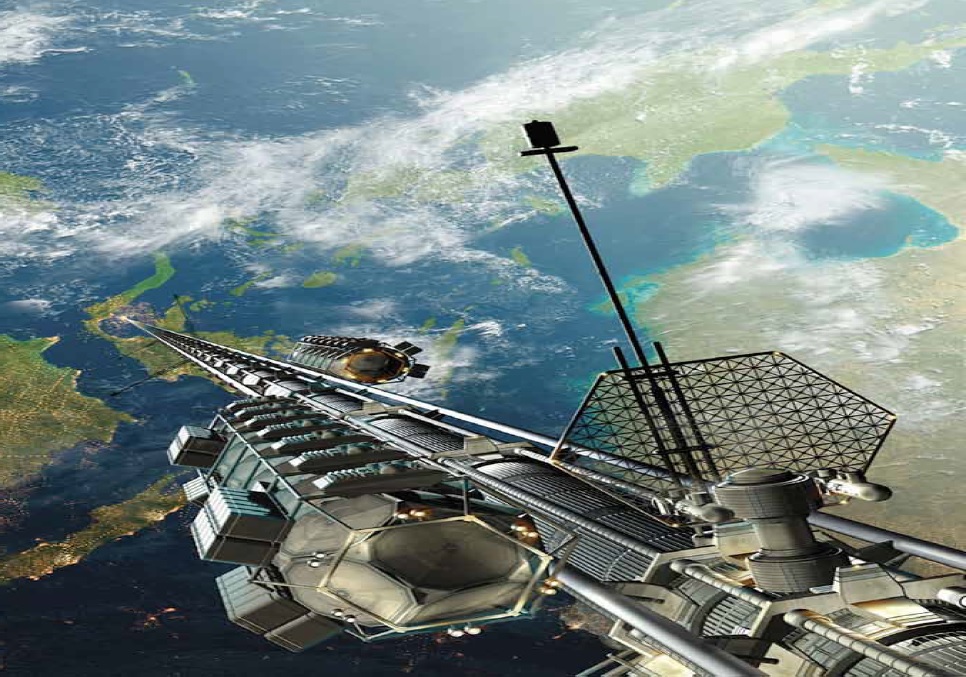
Picture: NASA
An accomplished scientist, O’Neill was already renowned for creating a machine that temporarily stores high-energy particle beams in magnetic fields so that they can be released, on command, to smash into other beams: a crucial technology behind particle colliders. However, by 1969 he was experiencing the classic inventor’s disenchantment with senior management at the institutions where he worked and was on the lookout for fresh inspiration. He found it in the wake of Apollo 11’s lunar touchdown. As he recalled for a NASA interview a few years later, “It just seemed to me that to be alive at that time, and not to try to take part in that unique event in human history, the first breakout from the planetary surface, would be something I would regret forever.”
At first, O’Neill incorporated space exploration just as a theoretical concept to stretch the imaginations of his students. “This was the peak time of disenchantment with anything in science and engineering. The students who were good at it felt very defensive, because all of their friends were saying that they weren’t doing anything relevant.” Then something remarkable happened. The students, a select group of half a dozen or so, took up O’Neill’s challenge with enthusiasm, and together they and their tutor formulated a plan for space that addressed the concerns of people on Earth: the 1970s energy crisis, triggered by international oil embargoes and the growing awareness that the climate was in trouble. One of their primary inspirations was World3, a computer simulation that predicted urgent resource shortages in the near future.
In 1968 the Italian industrialist Aurelio Peccei and Scottish scientist Alexander King founded an influential think tank known as the Club of Rome. Their purpose was to help solve perceived global problems. Seeking disciplined data about the environment, they commissioned a team of analysts at the Massachusetts Institute of Technology (MIT) led by biochemist Donella H. Meadows. In 1972 their book The Limits to Growth, based on the World3 calculations, caused an international sensation by stating that the Earth was running out of natural resources and that humanity’s ever-growing population could not be supported indefinitely.
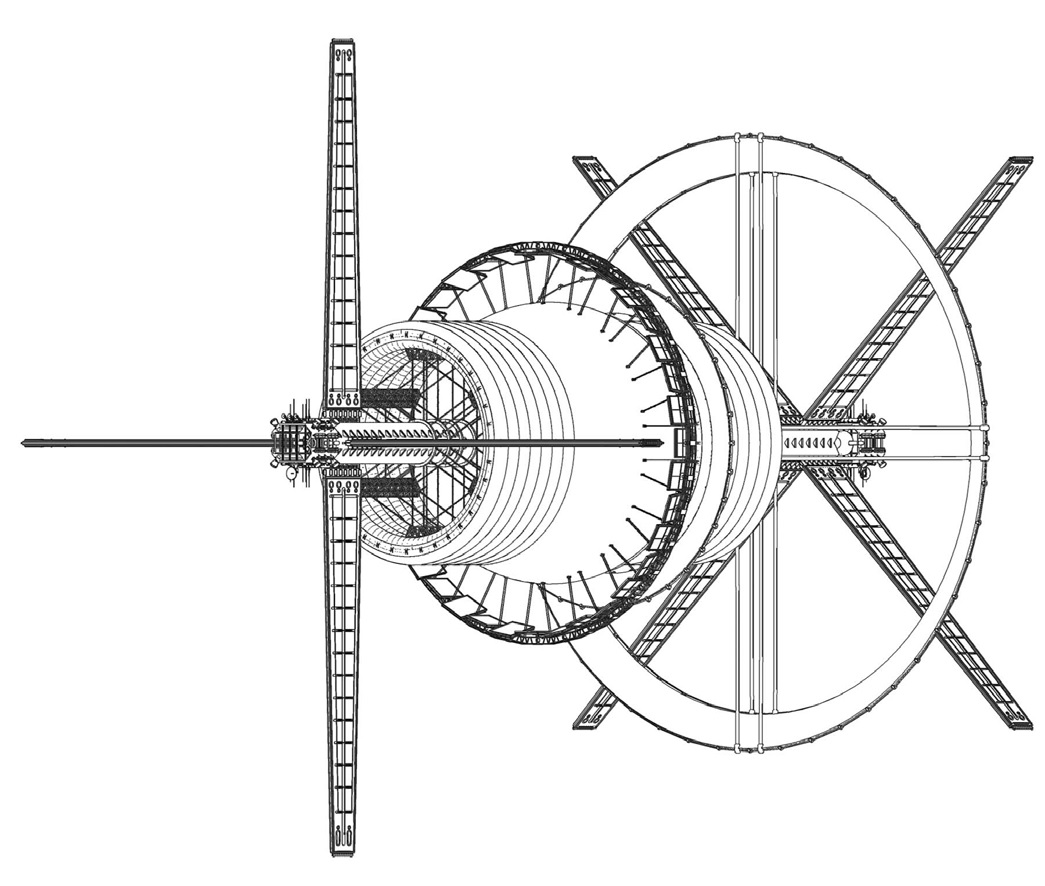
Space colonies may seem impossible right now, but they could become everyday homes for our great grandchildren. Picture: NASA/National Space Society
That was quite a shocking thought at the time. Spurred by this idea, and by the obvious passion of his students, O’Neill began to talk about “space as a place for people to be in, not just to look at.” He became convinced that “the long-term survival of humanity, and of the plant and animal life that we cherish on Earth, can best be assured by building colonies dispersed throughout our solar system and beyond.” He also hoped to “reduce the constant threat of wars by opening a new frontier with virtually unlimited new lands and new wealth.”
O’Neill’s technical research hit a nerve with its detailed studies of finite closed-loop ecological systems: an urgent concern for environmental campaigners. Everything inside his colonies would have to be recycled, from food packaging to human bodily waste products. Especially popular was his proposal that all heavy industry and energy production should be taken into space, thus saving the Earth from the burdens of pollution. O’Neill’s 1976 book The High Frontier: Human Colonies in Space, which profiled these ideas, was a bestseller.Three designs were highlighted in the book. Island One is a rotating sphere one mile in circumference. Its inhabitants occupy the equatorial region. The colonies get larger with each generation. Next up is Island Two, resembling the classic Wernher von Braun wheel-shaped station, only much grander in scale and capable of supporting ten thousand people. A free-flying mirror floats near the settlement, reflecting sunlight into the living areas of the torus.
The ultimate design is Island Three. A pair of “O’Neill Cylinders,” each up to twenty miles long and five miles in diameter, would be linked at their ends by adjustable beams. Each cylinder would rotate in the opposite direction to the other: a simple way of maintaining their correct orientation to the Sun gyroscopically, without expending thruster fuel. Inside the cylinders, three lengthwise land areas alternate with three window strips, illuminated with mirrors that open and close to create a familiar cycle of day and night. Each cylinder rotates about forty times an hour, simulating Earth’s gravity. A total land area of five hundred square miles accommodates several million people. An outer ring of greenhouse pods provides plenty of food.
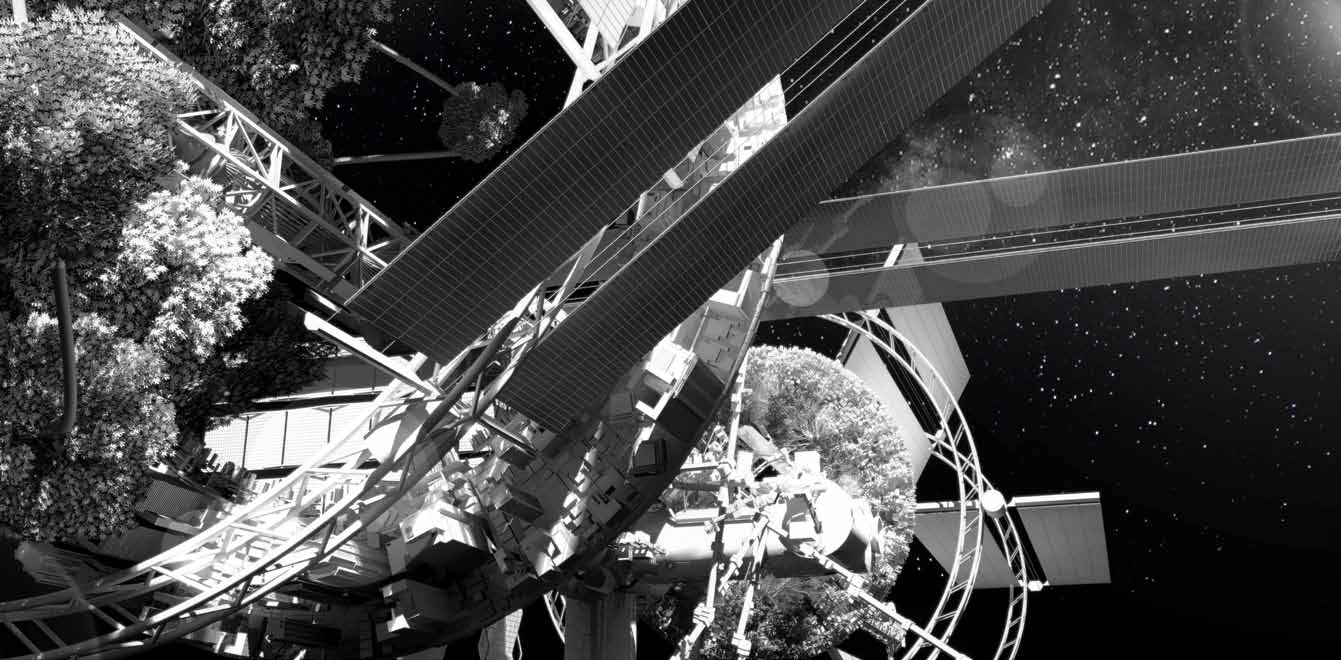
A fusion of mechanical and biological life support systems may lead to “living spaceships.” Picture: Project Persephone
O’Neill’s research assistant, Eric Drexler, proposed simple inflatable structures that would be rotated in front of a metal vapor spray, similar to the devices used to dope microchips with their many different layers of conductor. Wires or rods of raw materials would be fed into the system, melted into vapor, then deposited at relatively low temperatures on the surface of the plastic template. He knew what he was talking about. Today Drexler is one of the world’s leading pioneers of nanotechnology, the technique that allows objects of any size to be engineered upward from the molecular level.
Within each gigantic shell, O’Neill wanted to build a leafy paradise. “I had no desire to just invent a space station. It had to be beneficial for a lot of people. It had to look an awful lot like the Earth.” But how was all this to be funded? The colony’s initial purpose was to house the builders of the ultimate nonpolluting power system for Earth itself. According to O’Neill, solar energy was the obvious way to go. Gigantic orbiting arrays convert sunlight into a microwave beam, while, on Earth, fields of collector dishes in unpopulated deserts gather the microwave energy and reconvert it into electricity. This would pay for a colony in less than twenty-five years, he calculated.
O’Neill never once considered the space community’s usual goal of colonizing other worlds. “We side-tracked that very quickly because Mars, or any other alternative planetary surfaces, are fairly unpleasant options. They are the wrong distance from the sun, and have the wrong gravities.” He saw no sense in giving up the solar energy available in near-Earth space in favour of the cold, weak sunlight available on a distant planet.
On January 19, 1976, O’Neill testified before the U.S. Senate Subcommittee on Aerospace Technology and National Needs. The hearing room was packed to overflowing as he held out the prospect of an “inexhaustible energy source” for an initial outlay of no more than three times the cost of Project Apollo. In its subsequent report, the committee said that space habitats were “potentially feasible” and deserved more study. Above all, “methods for space-based generation of electricity, using energy from the sun, should be developed as a significant contribution to the fossil fuel dilemma.”

Artwork from the 1970s depicts the interior of an O’Neill Cylinder space colony. Picture: NASA/National Space Society.
NASA was not in a position to build any hardware, but made some funding available for theoretical studies, including conferences at Stanford University during 1975 and 1976, where O’Neill’s ideas gained real academic stature. The only serious flaw in the plan — and perhaps one that NASA was happy to fudge — was O’Neill’s casual approach to the first crucial crews and payloads that would need to escape from Earth in order to get the manufacturing processes under way. Everyone expected too much from the Space Shuttle, which had yet to make its first flight. The lunar mass driver, O’Neill reckoned, would call for “a year’s worth of shuttle flights.” No one among his team gave serious thought to the problem of launch vehicles, let alone the differences between an Earth-orbiting shutte and the hardware required for the first post-Apollo touchdowns on the moon or the initial cramped quarters for the first colony engineers. “We would use the shuttle’s external tanks to make modular living quarters for use in low and high orbit and on the lunar surface,” O’Neill wrote, somewhat optimistically.
Just a few minutes’ drive from O’Neill’s offices at Princeton, a firm of consultants was studying the shuttle’s economic benefits for NASA. They suggested that thirty nine flights per year, with up to five hundred flights conducted between 1978 and 1990, transporting humans and cargo alike in the same vehicles, would make the shuttle a winner. O’Neill took this on faith. Of the many wonderful visualizations in The High Frontier made by artist Don Davis, none specify customised launch hardware. With Apollo so recently triumphant, it seemed obvious to most people that NASA would come up with some solution.
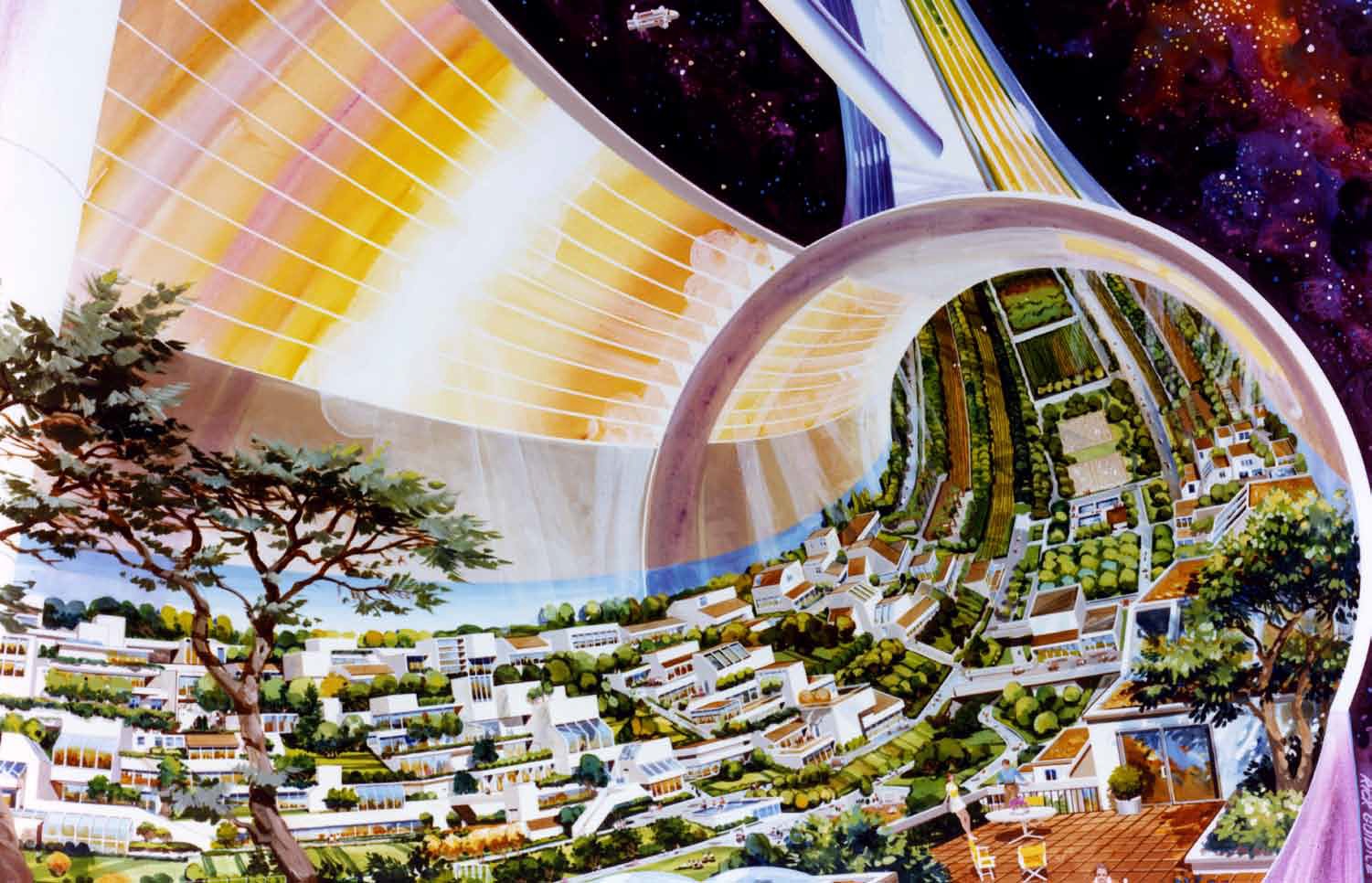
An alternative proposal, known as the Stanford Torus, is shaped like the innertube of a car tyre. Picture: NASA/National Space Society
O’Neill died of leukaemia on April 27, 1992, at the age of 66. Thousands of space enthusiasts lost an inspirational figure that day. But his ideas haven’t gone away. It has become possible once more to talk about harnessing solar energy in space, albeit on a smaller scale than O’Neill would have liked. Perhaps the private sector will take the lead. Entrepreneur and space activist Bob Werb collaborated with O’Neill in the late 1970s, before founding another high-profile lobbying group, Space Frontiers, in the 1980s. “The value of Gerard’s vision is, if anything, more certain today than ever. The proposed new direction for NASA is fundamentally O’Neillian, because it looks toward enabling technologies that will benefit all of us, instead of just small groups of astronauts.” With private space station pioneers such as Bigelow in mind, Werb suggests that “the scale of Island Three is still way beyond our current capabilities, but small-scale settlements are going to happen very soon.”
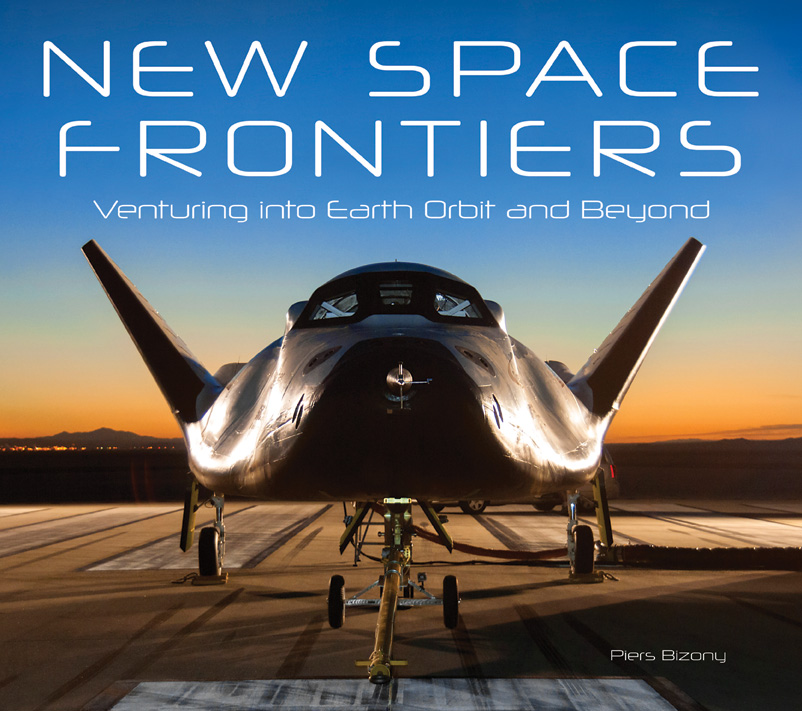
Excerpted with permission from New Space Frontiers: Venturing into Earth Orbit and Beyond by Piers Biznoy
